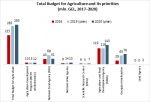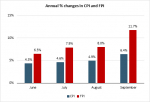Retail food prices decreased by 7.6% m/m (compared to the last week of May) and 10.1% y/y (compared to June 2015). The biggest drops were observed for tomatoes (-65.5%), cucumbers (-63.3%) and eggplant (-33.7%). Only a few products gained in value. The highest increases were recorded for cabbage (12.8%), tea (7.3%) and rice (7.2%).
TBILISI FOOD PRICES REACH MINIMUM
Retail FPI reached its lowest mark at the end of June with the main drivers being fresh fruits and vegetables. On the one hand, price declines in the fresh produce category are always expected at this time of the year, however, the 10.1% y/y decline in prices comes as a nice surprise for those poor consumers who could not escape 30+ temperatures and stayed in Tbilisi. Such a sharp annual change in prices requires an explanation other than seasonality.
One place to look for an explanation is Turkey. Ever since downing the Russian Su-24 over Syria, Turkish fruit and veggies were banned from the Russian market. Come high season, Turkish agricultural producers and traders started aggressively looking for alternative markets. Official data that are currently available to us do not allow to disaggregate Georgia’s fruit and vegetable imports by source country. However, we do observe very strong y/y growth in the overall fruit and vegetable imports during the first 5 months of 2016 (up 7.7% in value). Turkey is likely to be behind this increase in imports. Moreover, given that Turkey is dumping its fresh agriculture products on the international markets, the increase in the physical volume of fruit and vegetable imports is certainly larger than 7.7%, resulting in a glut.
FPI survey is only targeting Tbilisi-based supermarket chains, which may somewhat bias the results. With the summer heat wave hitting the capital, many families have moved to their summer cottages and villages. As a result of this seasonal migration, demand for food is likely to have increased in rural Georgia at the expense of Tbilisi. This suggests that food prices may not have declined by as much outside the capital.
WHO IS WINNING AND WHO IS LOSING FROM LOW FOOD PRICES?
To the extent that food prices decline as a result of increased supply, low prices benefit consumers but are bad news for Georgian producers. How about the retail sector? Well, even though food demand is relatively inelastic, if at all, food consumption is likely to increase as a result of lower prices. Regardless, however, supermarkets may still be able to charge reasonable markups.
If, on the other hand, food prices decline as a result of weaker demand, supermarkets stand to lose, big time. The latter effect appears to be dominating in Tbilisi, at least according to ISET PI’s Business Confidence Index (BCI) data. Our BCI survey suggests that retail (in general) was the only sector that experienced a setback in actual performance and expectation in the second quarter of 2016. BCI for the food retail sector has taken a hit of 8 index points (on a scale of -100;+100).
The situation for Georgian producers may get better in light of Erdogan’s recent apology letter and the expected rapprochement between Turkey and Russia. If Russia lifts its ban on Turkish products, we may see less agricultural products inundating the Georgian market, restoring the status quo in the food retail market.
Food Price Index Recent Publications
-
JUNE 2021 | AGRI REVIEW
 On 15 June 2021, the National Statistics Office of Georgia published its annual publication for the agricultural sector - Agriculture of Georgia 2020. According to the publication, agriculture, forestry, and fishing comprised 8.4% of GDP in 2020, higher than the 7.2% share in 2019, but in line with the general trend over the last five years (agricultural GDP comprising on average 7-8% of GDP). Agricultural GDP in nominal terms increased by 13% on an annual basis.… Read More
On 15 June 2021, the National Statistics Office of Georgia published its annual publication for the agricultural sector - Agriculture of Georgia 2020. According to the publication, agriculture, forestry, and fishing comprised 8.4% of GDP in 2020, higher than the 7.2% share in 2019, but in line with the general trend over the last five years (agricultural GDP comprising on average 7-8% of GDP). Agricultural GDP in nominal terms increased by 13% on an annual basis.… Read More
-
MARCH 2021 | AGRI REVIEW
 On 29 December 2020, the parliament of Georgia approved the state budget for 2021, which includes allocations of around 18.3 billion GEL. From which the Ministry of Environmental Protection and Agriculture (MEPA) will receive 451.6 million (2.5% of the total budget allocation). MEPA will direct 10 mln. GEL towards the Environmental Protection and Agriculture Development Program (2.2% of MEPA’s total budget), with around 389.6 mln. (86.3% of MEPA’s total budget) to be allocated to agricultural… Read More
On 29 December 2020, the parliament of Georgia approved the state budget for 2021, which includes allocations of around 18.3 billion GEL. From which the Ministry of Environmental Protection and Agriculture (MEPA) will receive 451.6 million (2.5% of the total budget allocation). MEPA will direct 10 mln. GEL towards the Environmental Protection and Agriculture Development Program (2.2% of MEPA’s total budget), with around 389.6 mln. (86.3% of MEPA’s total budget) to be allocated to agricultural… Read More
-
DECEMBER 2020 | AGRI REVIEW
 The COVID-19 pandemic raised concerns about the food security of many countries, in particular import-dependent developing countries like Georgia. Trade restrictions imposed by Georgia’s trade partners tightened the supply of some cereals and vegetables, signalling the risk of an increase in food prices. While there is no formal evidence of food insecurity due to the pandemic, given that Georgia is a net importer of wheat the state subsidized wheat imports, and, according to Georgia’s Wheat… Read More
The COVID-19 pandemic raised concerns about the food security of many countries, in particular import-dependent developing countries like Georgia. Trade restrictions imposed by Georgia’s trade partners tightened the supply of some cereals and vegetables, signalling the risk of an increase in food prices. While there is no formal evidence of food insecurity due to the pandemic, given that Georgia is a net importer of wheat the state subsidized wheat imports, and, according to Georgia’s Wheat… Read More
-
OCTOBER 2020 | AGRI REVIEW
 The National Statistics Office of Georgia (GeoStat) recently published its economic review for Quarter II 2020. The publication highlights that agricultural production increased by 4.7% in the second quarter of the year compared to the same period in 2019. Furthermore, agriculture contributed to 10.2% of the country’s total GDP during the same period. In the second quarter of 2020, Foreign Direct Investments (FDI) in agriculture also increased and were almost six times higher than the… Read More
The National Statistics Office of Georgia (GeoStat) recently published its economic review for Quarter II 2020. The publication highlights that agricultural production increased by 4.7% in the second quarter of the year compared to the same period in 2019. Furthermore, agriculture contributed to 10.2% of the country’s total GDP during the same period. In the second quarter of 2020, Foreign Direct Investments (FDI) in agriculture also increased and were almost six times higher than the… Read More
-
JUNE 2020 | AGRI REVIEW
 On 15 June 2020, the National Statistics Office of Georgia published its annual publication for the agricultural sector - Agriculture of Georgia 2019. The publication shows that agriculture, forestry, and fishing comprised 7.2% of the nominal GDP in 2019, slightly lower than the 7.8% share in 2018, but in line with the general trend over the last five years (on average 7-8% of GDP). In nominal terms, the output of agriculture increased by 4% in 2019… Read More
On 15 June 2020, the National Statistics Office of Georgia published its annual publication for the agricultural sector - Agriculture of Georgia 2019. The publication shows that agriculture, forestry, and fishing comprised 7.2% of the nominal GDP in 2019, slightly lower than the 7.8% share in 2018, but in line with the general trend over the last five years (on average 7-8% of GDP). In nominal terms, the output of agriculture increased by 4% in 2019… Read More
-
DECEMBER 2019 | AGRI REVIEW
 On December 10, the parliament of Georgia approved the state budget for 2020. The budget includes allocations of around 14.4 billion GEL. Out of which, the Ministry of Environmental Protection and Agriculture (MEPA) will receive 353 mln. GEL (2.4% of the total budget allocation). MEPA will direct approximately 293 mln. GEL (2.0% of the total budget allocation) towards agricultural development and 60 mln. GEL (0.4%) will be spent on environmental protection. Compared to 2019, the… Read More
On December 10, the parliament of Georgia approved the state budget for 2020. The budget includes allocations of around 14.4 billion GEL. Out of which, the Ministry of Environmental Protection and Agriculture (MEPA) will receive 353 mln. GEL (2.4% of the total budget allocation). MEPA will direct approximately 293 mln. GEL (2.0% of the total budget allocation) towards agricultural development and 60 mln. GEL (0.4%) will be spent on environmental protection. Compared to 2019, the… Read More
-
OCTOBER 2019 | AGRI REVIEW
 On 30 August 2019, a public hearing to discuss Georgia’s Rural and Agricultural Development Strategy for 2021-2027 was conducted at the Ministry of Environmental Protection and Agriculture (MEPA). The new strategy document represents a roadmap for Georgia’s rural and agricultural development for the next decade. The strategy outlines three major goals to be achieved by 2027: 1. Increasing the competitiveness of agricultural and non-agricultural sectors; 2. Sustainable management of natural resources, preservation of ecosystems, and… Read More
On 30 August 2019, a public hearing to discuss Georgia’s Rural and Agricultural Development Strategy for 2021-2027 was conducted at the Ministry of Environmental Protection and Agriculture (MEPA). The new strategy document represents a roadmap for Georgia’s rural and agricultural development for the next decade. The strategy outlines three major goals to be achieved by 2027: 1. Increasing the competitiveness of agricultural and non-agricultural sectors; 2. Sustainable management of natural resources, preservation of ecosystems, and… Read More
- 1
- 2
- 3
- 4
- 5
- 6
- 7
- 8
- 9
- 10











